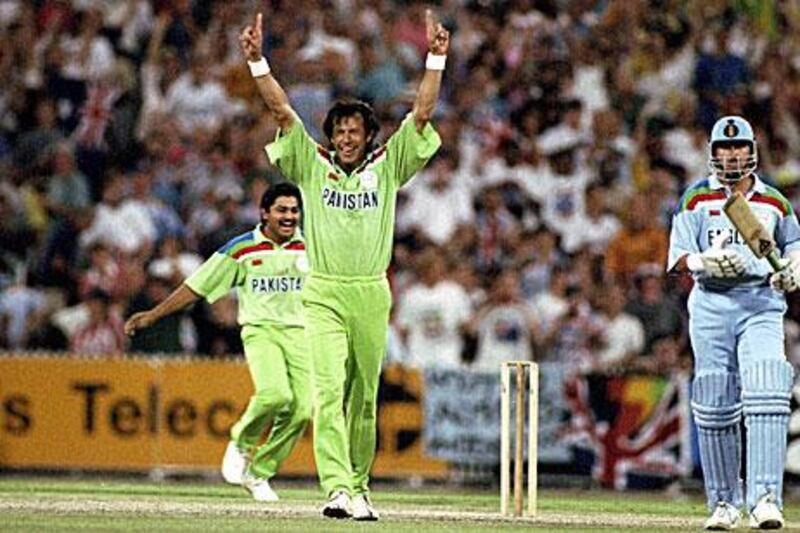Pakistan celebrated its 64th birthday yesterday and, in the time since it was made an independent nation, cricket has become an important element in its culture.
The Pakistan landscape seems indelibly marked by the game.
The fact that cricket has become the No 1 sport in the country was by no means inevitable.
The first Test match team to represent Pakistan contained seven players born in Lahore and four who were born in what became India.
This was an indication that cricket at the popular level in the country in the 1950s was not greatly developed.
Containing many of the economic backwaters of the subcontinent, Pakistan had begun its existence with a low industrial base and a small middle class. This was significant as, at that stage, the game on the subcontinent was mainly a sport for the privileged.
The two most advanced cricket centres in Pakistan, when the partitioner's axe was wielded in 1947, were Lahore and Karachi.
In Karachi, pre-partition, the Hindus and Parsees dominated the cricket scene, and in Lahore, Hindus and Sikhs were responsible for much of the organisational structure. Hindus, Parsees and Sikhs - being in an economically superior position to Muslims - funded much of the cricket in Lahore and Karachi.
Partition, of course, led to the migration of these communities to India and left Pakistan cricket to start its life without patrons, funds and organisational strength.
The Board of Cricket Control Pakistan (BCCP, as the game's governing body was known then) and the domestic structure had to be created from scratch.
Faced by financial constraints, poor facilities, the lack of a strong grass roots structure and seeking legitimacy, the BCCP looked to important figures - private and public - which not only led to a politicised structure emerging, but encouraged intrigue.
Many years on, the Pakistan Cricket Board (PCB, as the governing body is known now) is still a weak institution and the domestic structure remains feeble, unable to shake off the legacy of the past and the troubled beginnings.
But cricket's geographic appeal and social base are now much wider. It is no longer merely a game for the privileged from urban areas, with its player strength restricted to Lahore and Karachi, as it was in the 1950s - although these two cities remain influential cricketing centres.
Not only has the game spread, but Pakistani cricket has been quite successful when one considers the many constraints that it has faced.
The success can be ascribed in large part to its ability to turn apparent disadvantages into positives and, in the process, develop a lively cricket culture of its own.
The decline of schools and college cricket limited funds, as well as the widening of the social base, meant that increasingly from the mid-1960s and beyond, youngsters who went on to represent Pakistan had learnt their trade on the streets. The spatial restrictions promoted unorthodox styles that continue to this day.
The fact that many Pakistanis obtained formal coaching only when they entered the domestic first-class arena encouraged individuality and an improvisatory style.
The weak domestic system, an informal cricket structure and an emphasis on patronage also encouraged the fielding of young players based not on domestic performances but potential.
There was a tendency for influential senior players to recruit young players. Often they did so without regard to domestic performances.
Indeed, many of them held first-class cricket in low regard. As such, not only was the weak domestic system circumvented, but players were picked before their individual distinctiveness was eroded in the first-class game.
The weakness and informal nature of the cricket structure also led to empowered captains. Not circumscribed by bureaucracy and red tape, they often wielded immense power.
While at times this power has been abused, leading to claims of nepotism and favouritism, under a strong visionary captain such as Imran Khan, it also ensured that sound cricket decisions were being made in spite of the nature of the PCB.
The growth in the social base also had a significant impact in the emergence of a more defiant spirit in the 1970s. In the initial years, many of the cricketers who represented Pakistan were educated and affluent, and had learnt their cricket in the college system based on British educational institutions. These players were more deferential in spirit. The emergence of players from poorer backgrounds, not steeped in British traditions, allowed for a more assertive attitude to emerge.
But as Pakistanis may contemplate how cricket has succeeded in some ways against the odds, they may also reflect on some of the problems it faces.
Indeed, at the moment, Pakistan cricket is at a low point. Many of its problems can be linked to poor administration, which itself is a product of history. Urgent reform is required to the PCB.
The chairmen of the PCB have historically behaved in authoritarian fashion and lacked cricket knowledge. They have been largely unaccountable for their actions.
The PCB needs to be democratised with power more widely diffused and the chairman's remit more clearly spelt out. More emphasis is needed on good corporate governance.
An outdated process, where the president of the country chooses the PCB chairman, needs to be put to an end.
A reformed PCB needs to also address the fact that, despite the game widening its net, few cricketers come from the many poorer areas of Pakistan - west and south Punjab, Balochistan and interior Sind. For a sport that is considered the national game and that is seen an integrative force, it is a disappointing state of affairs.
Pakistan's cricket culture can only be further enriched by incorporating players from the less privileged areas of Pakistan.
These problems notwithstanding, cricket in Pakistan embodies Pakistani aspirations and pride. Shaped by history and environment, faced by a plethora of constraints, Pakistan cricket has developed a particularly distinctive and vibrant cricket culture.
On Pakistan's 64th birthday, it was well worth celebrating it.





